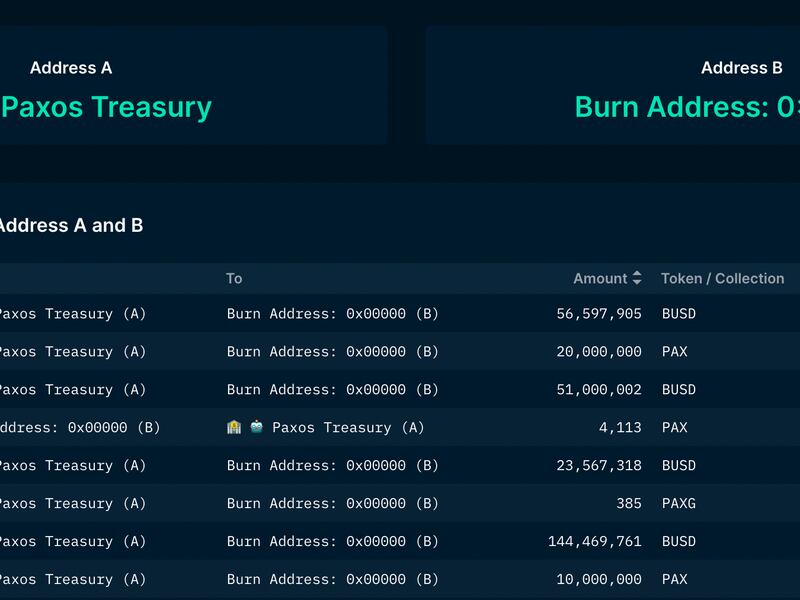Binance USD's $16B Market Cap Up for Grabs as SEC-Paxos Suit Stirs Up Stablecoin Rivalry

The decision by stablecoin issuer Paxos to stop issuing Binance USD (BUSD) after a fresh lawsuit from the U.S. Securities and Exchange Commission (SEC) will shake up the $136 billion stablecoin market – with industry leaders Tether’s USDT and Circle’s USDC likely to gain share.
Another winner could be MakerDAO’s DAI, the leading decentralized stablecoin.
Binance, the world’s largest crypto exchange by trading volume, had invested heavily to promote BUSD’s use on the platform. While Paxos, a New York-based fintech firm, was the official issuer of the stablecoin, Binance lent its brand to the token.
In September, Binance even took the drastic step of ditching trading pairs involving Circle’s USDC and requiring trades in BUSD. The move quickly helped grow BUSD to become the third-most popular stablecoin, with $16 billion outstanding, and it claimed 35% of Binance’s monumental trading volume.
Now, with the U.S. securities watchdog’s crackdown, that effort is grinding to a halt, opening the way for rivals to reclaim ground. Binance CEO Changpeng “CZ” Zhao wrote Monday in a tweet that “BUSD market cap will only decrease over time.”
USDT is the largest stablecoin, with some $69 billion outstanding, followed by USDC at $41 billion, according to CoinGecko data. DAI’s market cap is $5 billion.
“Paxos' decision will profoundly alter the stablecoin space and upends a pillar of Binance's strategy for global crypto dominance,” Clara Medalie, digital asset analysis firm Kaiko’s director of research, told CoinDesk.
#BUSD. A thread. 1/8
— CZ 🔶 Binance (@cz_binance) February 13, 2023
In summary, BUSD is issued and redeemed by Paxos. And funds are #SAFU!
The SEC’s action against Paxos opens a fresh chapter in the fierce rivalry for dominance on the stablecoin market. Stablecoins have grown to a $135 billion class within crypto, are the backbone for the crypto ecosystem and sometimes hailed as the “crypto’s killer use case.”
By maintaining a fixed price, usually pegged to the U.S. dollar, the tokens are essential to facilitate trading digital assets on exchanges and transfer value between traditional fiat money and cryptocurrencies.
“This headwind will lead to a consolidation in the stablecoin market towards blue chips such as Tether and USDC,” Leena ElDeeb, research associate of digital asset firm 21.co, said in an email. “The winner will most likely be Tether, as we are seeing millions of dollars of inflows to USDT on Binance.”
Read more: Circle Sounded Alarm on Paxos, Told NYDFS Binance’s Stablecoin Wasn’t Fully Backed
Said Kaiko’s Medalie: “USDC also has much to gain with the absence of BUSD, and it will be interesting to see if Binance re-lists the stablecoin.”
However, some have raised concerns that Circle might be the next target of the SEC’s enforcement campaign on stablecoin issuers.
“If they take these circumstances to their advantage, we may witness the rise of decentralized stablecoins such as DAI in resistance against censorship,” ElDeeb said.
What’s next for Binance
Given that Binance only gave its brand to BUSD, Paxos’s decision is expected to have limited impact on the exchange’s finances.
“It may not impact their business too much,'' Conor Ryder, research analyst at Kaiko, said. “The damage is likely mainly reputational for now, especially after phasing out USDC and other stables.”
Read more: Binance Says BUSD ‘Funds Are Safu’ but a Regulatory Cloud Is Forming Over the US
It’s possible that the Paxos withdrawal may not be the end of Binance’s stablecoin aspirations.
“Binance may yet find another issuer for BUSD or find a different solution,” Megalie said. “There are still many variables at play, but for now we can expect traders to slowly start cashing out of their BUSD holdings.”
Traders ditching Binance USD
After the news about the SEC lawsuit broke, Paxos and Binance assured investors that BUSD redemptions will be honored until at least February 2024.
“This did not stop traders from rushing to the exits,” digital asset research firm Kaiko wrote in its morning newsletter.
Investors have been scrambling to get rid of their BUSD holdings, putting pressure on the token’s intended $1 peg, based on trading and blockchain data.
On Binance, the BUSD-USDT trading pair’s spot trading volume surpassed $3 billion in the past 24 hours, recording the largest daily volume since the November market crash induced by the implosion of FTX.
In the largest BUSD pool on decentralized finance (DeFi) protocol Curve, where traders can swap between stablecoins, traders almost depleted the USDT, USDC and DAI liquidity. Now, 85% of the pool’s liquidity is BUSD, making it difficult for traders to exchange large amounts of BUSD, and forcing sellers to accept losses at the discounted exchange rates. At current rates, a trader exchanging 10,000 BUSD will receive 9,982 USDT.
Additionally, blockchain data on Nansen shows that the Paxos treasury on Monday had already transferred some $275 million of BUSD to a burn address, taking those tokens out of circulation.

Read more: BNB Token Slides Under $300, Binance USD Inflows Signal Bearish Signs








